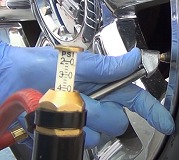Wheel bearings on all brands of front-wheel-drive cars often become noisy. They will sound like the buzz of an airplane engine. The noise usually doesn't change from cruising to coasting. On some cars with the less-expensive pressed-in bearings, it is often possible to determine which one is noisy by turning slightly as in changing lanes. If it gets louder when you turn left, it's the right bearing and more weight has shifted onto it.
With the more-expensive-to-buy / less-labor-to-replace bolt-on type bearing used by GM, that trick doesn't work. It can sound like the noise is coming from the left side, won't change when turning or might even get louder when turning right, ... And it will be the right bearing. The only way I've found that always works is to run it in gear on a hoist, then listen next to each one with a stethoscope. One will be a lot louder than the other one. Some people say you can spin the wheel by hand with the car jacked up, and feel the vibration of the noisy bearing by feeling the body of the strut. I haven't had the chance to try that but if it works, I would still listen with the stethoscope until I had enough experience to trust what I was feeling.
Thursday, November 8th, 2012 AT 10:27 AM



